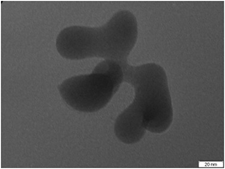Crossref Citations
This article has been cited by the following publications. This list is generated based on data provided by
Crossref.
Gonçalves, M. D.
Maram, P. S.
Muccillo, R.
and
Navrotsky, A.
2014.
Enthalpy of formation and thermodynamic insights into yttrium doped BaZrO3.
J. Mater. Chem. A,
Vol. 2,
Issue. 42,
p.
17840.
Camargo, Emerson R.
Dancini, Mayra Gonçalves
and
Kakihana, Masasto
2014.
The oxidant peroxo method (OPM) as a new alternative for the synthesis of lead-based and bismuth-based oxides.– CORRIGENDUM.
Journal of Materials Research,
Vol. 29,
Issue. 4,
p.
607.
Nogueira, André E.
Lima, Alan R. F.
Longo, Elson
Leite, Edson R.
and
Camargo, Emerson R.
2014.
Structure and photocatalytic properties of Nb-doped Bi12TiO20 prepared by the oxidant peroxide method (OPM).
Journal of Nanoparticle Research,
Vol. 16,
Issue. 12,
Nogueira, André E.
Longo, Elson
Leite, Edson R.
and
Camargo, Emerson R.
2015.
Visible-light photocatalysis with bismuth titanate (Bi12TiO20) particles synthesized by the oxidant peroxide method (OPM).
Ceramics International,
Vol. 41,
Issue. 9,
p.
12073.
Nogueira, André E.
Lima, Alan R.F.
Longo, Elson
Leite, Edson R.
and
Camargo, Emerson R.
2015.
Effect of lanthanum and lead doping on the microstructure and visible light photocatalysis of bismuth titanate prepared by the oxidant peroxide method (OPM).
Journal of Photochemistry and Photobiology A: Chemistry,
Vol. 312,
Issue. ,
p.
55.
do Prado, Nayara T.
Souza, Talita E.
Machado, Alan Rodrigues T.
Souza, Patterson P.
Monteiro, Robson S.
and
Oliveira, Luiz C.A.
2016.
Enhanced catalytic activity for fructose conversion on nanostructured niobium oxide after hydrothermal treatment: Effect of morphology and porous structure.
Journal of Molecular Catalysis A: Chemical,
Vol. 422,
Issue. ,
p.
23.
Gonçalves, Mayra D.
Souza, Flavio L.
Longo, Elson
Leite, Edson R.
and
Camargo, Emerson R.
2016.
Dielectric characterization of microwave sintered lead zirconate titanate ceramics.
Ceramics International,
Vol. 42,
Issue. 13,
p.
14423.
Francatto, P.
Souza Neto, F.N.
Nogueira, A.E.
Kubo, A.M.
Ribeiro, L.S.
Gonçalves, L.P.
Gorup, L.F.
Leite, E.R.
and
Camargo, E.R.
2016.
Enhanced reactivity of peroxo-modified surface of titanium dioxide nanoparticles used to synthesize ultrafine bismuth titanate powders at lower temperatures.
Ceramics International,
Vol. 42,
Issue. 14,
p.
15767.
Lopes, Osmando F.
Carvalho, Kele T.G.
Nogueira, André E.
Avansi, Waldir
and
Ribeiro, Caue
2016.
Controlled synthesis of BiVO 4 photocatalysts: Evidence of the role of heterojunctions in their catalytic performance driven by visible-light.
Applied Catalysis B: Environmental,
Vol. 188,
Issue. ,
p.
87.
Gonçalves, Mayra D.
and
Camargo, Emerson R.
2017.
Lanthanum-doped PZT synthesized by the oxidant peroxide method and sintered by conventional and microwave routes.
Ceramics International,
Vol. 43,
Issue. 3,
p.
3004.
do Prado, Nayara T.
and
Oliveira, Luiz C.A.
2017.
Nanostructured niobium oxide synthetized by a new route using hydrothermal treatment: High efficiency in oxidation reactions.
Applied Catalysis B: Environmental,
Vol. 205,
Issue. ,
p.
481.
Bel-Hadj-Tahar, Radhouane
and
Abboud, Mohamed
2018.
Structural development and kinetic analysis of PbTiO3 powders processed at low-temperature via new sol-gel approach.
Solid State Sciences,
Vol. 78,
Issue. ,
p.
74.
Nogueira, André E.
Ribeiro, Lucas S.
Gorup, Luiz F.
Silva, Gelson T. S. T.
Silva, Fernando F. B.
Ribeiro, Caue
and
Camargo, Emerson R.
2018.
New Approach of the Oxidant Peroxo Method (OPM) Route to Obtain Ti(OH)4 Nanoparticles with High Photocatalytic Activity under Visible Radiation.
International Journal of Photoenergy,
Vol. 2018,
Issue. ,
p.
1.
Wang, Qi
Liu, Enqin
Zhang, Chenlu
Huang, Siwei
Cong, Yanqing
and
Zhang, Yi
2018.
Synthesis of Cs3PMo12O40/Bi2O3 composite with highly enhanced photocatalytic activity under visible-light irradiation.
Journal of Colloid and Interface Science,
Vol. 516,
Issue. ,
p.
304.
Ribeiro, Lucas S.
Nogueira, André E.
Aquino, José M.
and
Camargo, Emerson R.
2019.
A new strategy to obtain nano-scale particles of lithium titanate (Li4Ti5O12) by the oxidant peroxo method (OPM).
Ceramics International,
Vol. 45,
Issue. 18,
p.
23917.
de Mendonça, Vagner R.
Lopes, Osmando F.
Avansi, Waldir
Arenal, Raul
and
Ribeiro, Caue
2019.
Insights into formation of anatase TiO2 nanoparticles from peroxo titanium complex degradation under microwave-assisted hydrothermal treatment.
Ceramics International,
Vol. 45,
Issue. 17,
p.
22998.
Khacheba, Maria
Abdessalem, Noura
Hamdi, Ahmed
and
Khemakhem, Hamadi
2020.
Effect of acceptor and donor dopants (Na, Y) on the microstructure and dielectric characteristics of high Curie point PZT-modified ceramics.
Journal of Materials Science: Materials in Electronics,
Vol. 31,
Issue. 1,
p.
361.
Sarageng, Kanyarat
Wongprom, Wanpawee
Noorith, Weesuda
Lertsathitphong, Panjaphong
Crawford, Jessica
Nasongkla, Norased
O'Mullane, Anthony P.
and
Lertanantawong, Benchaporn
2022.
Using H2O2 as a green oxidant to produce fluorescent GaOOH nanomaterials from a liquid metal.
Chemical Communications,
Vol. 58,
Issue. 74,
p.
10412.
Bochenek, Dariusz
Chrobak, Artur
and
Dercz, Grzegorz
2022.
Influence of the Sintering Method on the Properties of a Multiferroic Ceramic Composite Based on PZT-Type Ferroelectric Material and Ni-Zn Ferrite.
Materials,
Vol. 15,
Issue. 23,
p.
8461.
Kaewdee, Pongpen
Limpichaipanit, Apichart
Randorn, Chamnan
and
Tandorn, Sujitra
2023.
Facile and composition controllable synthesis of lanthanum-doped strontium titanate via peroxide route.
Advances in Applied Ceramics,
Vol. 122,
Issue. 1,
p.
17.



